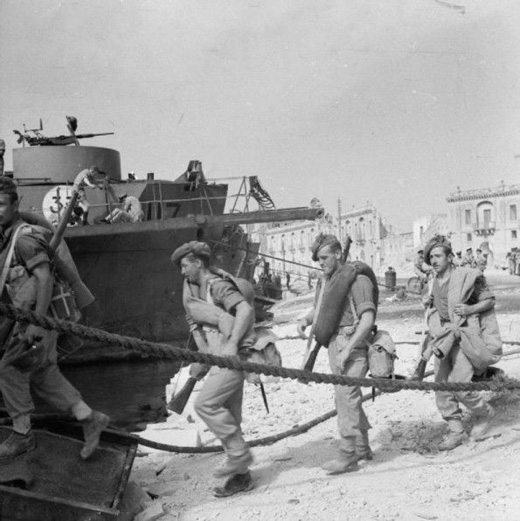Air Operations, Aleutians
6 28th Composite Bomb Group B-24s attack Kiska.
[Air Operations, Bismarcks
13 90th Heavy Bomb Group B-24s attack Rabaul-area airfields and 1 B-24 attacks the Cape Gloucester airfield on New Britain.
[Air Operations, CBI
BURMA- 341st Medium Bomb Group B-25s attack a bridge at Myitnge.
Air Operations, East Indies
380th Heavy Bomb Group B-24s attack the Kendari airfield on Celebes and 2 V Bomber Command B-25s attack Koepang, Timor.
[Air Operations, Europe
RAF BOMBER COMMANDEvening Ops:
- 653 aircraft are sent to Cologne. Included in the total are 293 Lancasters, 182 Halifaxex, 89 Wellingtons, 76 Stirlings and 13 Mosquitos.
- The target for this raid is that part of Cologne situated on the east bank of the Rhine, where a great deal of industry is located. Pathfinder ground marking is accurate and is maintained by both the Mosquito Oboe aircraft and the backers-up. The Main Force follows with their bomb loads causing extensive damage. Among the sites receiving extensive damage is the Humboldt-Deutz works which makes U-boat accumulators.
- This night sees the first operations of a new German unit, Jagdgeschwader 300, equipped with single-engined fighters using the Wilde Sau (Wild Boar) technique. In this, a German pilot uses any form of illumination available over a city being bombed
searchlights, target indicators, the glow of fires on the ground
to pick out a bomber for attack.
- Liaison with the local flak defences is supposed to ensure that the flak is limited to a certain height above which the Wild Boar fighter is free to operate. The new German unit claims 12 bombers shot down over Cologne but has to share the 12 available aircraft found to have crashed with the local flak, who also claims 12 successes.
- 9 Halifaxes, 8 Lancasters, 8 Wellingtons and 5 Stirlings are lost.
- 4 Mosquitos are sent to Duisburg, 4 more to Hamburg, and 14 Stirlings lay mines in the Frisians.
- 2 Stirlings are lost.
Air Operations, New Guinea
Approximately 7 Japanese bombers, escorted by A6M Zeros, attack the Nassau Bay beachhead, but they are intercepted by 14 49th Fighter Group P-40s returning to the airfield at Dobodura from another mission. P-40s of the 49th Fighter Groupís 7th Fighter Squadron down a Ki-46 'Dinah' recon aircraft and 5 of the Zeros between 1610 and 1615 hours.
[Air Operations, Sardinia
- NASAF (Northwest African Strategic Air Force) B-17s and B-25s attach the Alghero, Chilivani, and Monserrato Airdromes.
- NASAF B-26s attack the Capoterra and Milis Airdromes.
- A 14th Fighter Group P-38 downs 1 Bf-109 near Cagliari while covering one of the afternoon bombing missions.
Air Operations, Sicily
- IX Bomber Command B-25s attack the Comiso Airdrome.
- 33rd and 325th Fighter Group P-40s down 2 Luftwaffe fighters in separate actions over the Sciacca and Trapani/Milo Airdromes, respectively.
Air Operations, Solomons
- 42nd Medium Bomb Group B-25s attack the Munda Point airfield on New Georgia and antiaircraft emplacements.
- P-38s of the 347th Fighter Groupís 339th Fighter Squadron down 5 A6M Zeros near Rendova at about 1445 hours. The Zeros are part of a force of 40 that sweep the invasion area.
Battle of the Atlantic
- U-126 is sunk by Wellington 'R' of No 172 Squadron which detected the U-boat by radar. The aircraft dropped eight depth charges whice exploded on either side of the submarine causing her to sink.
- U-628 is sunk by Liberator 'J' of No 224 Squadron. A radar contact is reported and one minute later the U-boat is spotted. The aircraft makes two attacks, the first with depth charges and anti-submarine bombs and the second with just depth charges. After the second attack debris and bodies are seen in a large brown oil slick.
- The US freighter Elihu B. Washburne (7176t) is torpedoed and sunk by U-513 off the coast of Brazil without a loss of those on board.
|
|
Eastern Front
Operation CITADEL, the offensive for the elimination of the Russian Kursk salient, is delayed by preventive bombing by the Russians which holds up the deployment of the German forces.
[ British Troops Boarding Landing Craft |
 |
New Georgia
US forces land at Zanana about 8 miles east of Munda. There is no Japanese resistance and the beachhead is quickly consolidated.
[New Guinea
After heavy fighting in the Mubo area, the Australians advancing from Wau join up with the Americans from the Nassau Bay landing force in the region of the Bitoi River.
[Pacific
The US submarine Scorpion attacks a Japanese convoy in the Yellow Sea and sinks the merchant cargo ships Anzan Maru (3890t) and Kokuryu Maru (6112t).
[Solomons
On Vangunu Island the Americans occupy Wickham Anchorage.
[